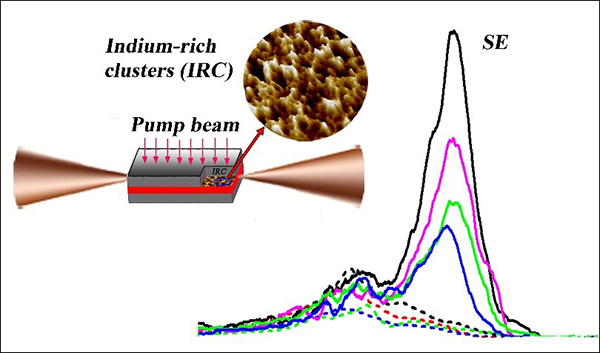Although light-emitting diodes (LEDs) and laser diodes (LDs) have been widely used for people's daily life and scientific fields, e.g. fiber communication and optical interconnection, medical application, industrial measurement and military. nowadays, scientists in the world still have been undertaking the research on seeking for better lightening material structure and disclosing their characteristics by theory and experiment to further enhance these semiconductors light-emitting device performance.
In the research of LEDs and LDs, a common nature of the semiconductor materials and devices is the unamplified spontaneous emission (SE). It is a basic but very important physical parameter for the lightening materials and devices because it describes the fundamental physical process of the light-matter interaction, in terms of the Einstein's light-emitting theory, and affects optical characteristics of the devices. In order to obtain the SE information from devices, both theoretical calculation and experimental measurement are developed. However, on the one hand, the current theoretical methods are only suitable for the ideal or standard quantum-confined models, e.g. quantum well or quantum dot structure and it is difficult to exactly characterize the SE characteristics of any abnormal quantum-confined structure. For example, the indium-rich cluster-induced (IRC) quantum structure described in the following paper mentioned is typically an abnormal one, which consists of many irregular InGaAs regions with different indium contents due to the influence from the IRC effect.
On the other hand, most of the existing experimental methods for obtaining SE information of the devices need fabricating a complex sample for measurement, which is usually hard to process in accuracy so that some additional measurement errors would be generated in acquiring the SE characteristics by experiment. Therefore, new experimental approaches for characterizing or acquiring exactly the SE characteristics of any quantum-confined structure, especially of non-standard quantum-confined structures are needed urgently. Since it is difficult to build a global theoretical model to calculate the SE characteristics of various material structures, the experimental approach will be more expected. A research group led by Prof. Jian Wu from Beihang University proposed a new experimental approach to acquiring the SE characteristics of semiconductor lightening structure. The method is simple and effective, as it does not need any complex sample processing and preparation. This method offers a global tool for obtaining the SE characteristics of any quantum-confined structures involving non-standard ones. Certainly, it is also aiming at serving for the investigation on SE characteristics of the special IRC quantum-confined structure based on InGaAs materials. The research results are published in Chinese Optics Letters, Vol. 18, Issue 5, 2020 (Ming Zheng, Qingnan Yu, Hanxu Tai, et al. Experimental investigation of spontaneous emission characteristics of InGaAs-based indium-rich cluster-induced special quantum structure[J]. Chinese Optics Letters, 2020, 18(5): 051403).
The IRC quantum-confined structure is a special and non-standard one from the InGaAs materials. It is formed due to the IRC effect in the InGaAs/GaAs materials. In the growth process of InGaAs/GaAs materials, indium atoms would partially leave from the InGaAs compound and move up to the surface of the InGaAs layer along the growth direction. This is because there exists a large stress in the InGaAs compound due to different lattices and sizes between indium atoms and gallium atoms. As a result, the indium atom's migration forms many island-like accumulations of the indium atoms on the surface of the InGaAs layer. It changes the original InGaAs quantum-confined structure and the optical characteristics. This phenomenon is called the IRC effect in the InGaAs materials. The IRC-induced special quantum-confined structure and its characteristics were paid attention recently. In order to investigate its optical characteristics, the SE spectrum and its features have to be known at first. Therefore, the group invented this new experimental method to measure the SE spectrum and analyze its features of the structure at first. This investigation is also the first time to reveal the SE characteristics of the InGaAs-based IRC quantum-confined structure. Thus, it is the new and very meaningful research work.
The experimental design of the method used simply a single edge-emitting chip without any complicated sample treatments except for coating by complete transmittance at one end of the chip. This avoided unnecessary measurement errors from inaccurate sample processing. The SE information of the IRC quantum structure were obtained and analyzed in the paper. The results showed two unusual SE features different from that of a standard InGaAs/GaAs quantum well. One was that the SE bandwidth was enormously broadened by 870-1000 nm for both of transverse electric (TE) and transverse magnetic(TM) polarization modes. The other was that there were double peaks emerging in any SE spectrum. These reflected the special emission features of the IRC quantum structure and were revealed for the first time. The brief analysis on these new findings were made in the paper. It needs further investigation in theory for more details in the future.
In the authors' opinions, the important meanings of this work are that not only it invented a new and effective experimental method for acquiring the SE information of any quantum-confined structures in LED or LD devices, but also revealed the SE characteristics and the special mechanism to generate in the IRC quantum structure for the first time. The future work based on this investigation will focus on more optical characteristics findings and mechanism analysis relating to the special IRC quantum confined structure to develop new types and high performance of LEDs and LDs.

Experimental characterization of spontaneous emission (SE) characteristics for the InGaAs-based indium-rich cluster-induced quantum structure by measuring the Photoluminescence Spectroscopy (PL) spectra from both facets of a single edge-emitting chip


